



Call Silver Star at 828-321-4268
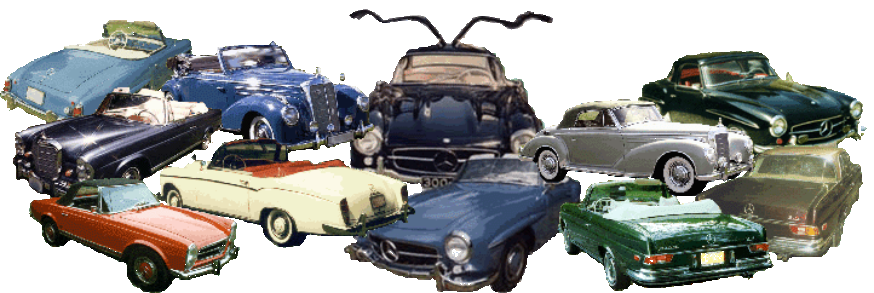

220SEb / 250SE / 280SE Cabriolets and Coupes 1961 - 1971

INTRODUCTION and HISTORY
This luxurious model was the last of the hand-built Mercedes. Only 13 cars per week rolled off the
production line. These cabriolets and coupes are true classics. Unlike other automobiles, these cars
were classics the day they rolled off the production line, and have remained so ever since.
The 220SEb was first introduced in 1961 and was considered to be an immediate success. Road & Track
magazine said "one of the best-looking body designs to come from any German concern." Exquisitely
proportioned and beautifully designed. Luxurious may very well be an understatement when describing
this model. There were no changes to the basic design until 1969. (Why mess with perfection, huh?)
Because of the high demand for convertibles, many coupes have been cut and converted into
convertibles, especially the 280 SE 3.5 coupes (as they are the most sought-after of the cabriolets.) SO
BE CAREFUL! This has been done so by unscrupulous people in the event of an unsuspecting customer
that comes to purchase a convertible. If you are looking at a convertible, make sure to check the chassis
number. If you are unsure of the car, call us with the chassis number and we will be happy to help verify
whether or not it is a true cabriolet. If you purchase a false convertible, it can cost you thousands of
dollars. Click here for information on what to avoid.
All of these coupes and convertibles are elegant, yet can still be driven and maintained with no fuss. The
later models with bigger engines are preferred, such as the 300 SE, (see separate page) which was rare
when it was new, and is a definite keeper now. The 280 SE 3.5 convertible is a definite collectible
because of it's power and grace, and also because of the grille, which is lower and wider. They are
elegantly trimmed out with leather and hard-wood veneer in the dash.
Production Numbers:
Production Numbers of the 220SEb from 1961 to 1965
Cabriolet chassis prefix is 111 023
engine prefix is 127 984
Coupe chassis prefix for is 111 021
engine prefix is 127 984
Cabriolets
2729 units
Coupes
14173 units
Total:
16902 units
Production Numbers of the 250SE from 1965 to 1967
Cabriolet chassis prefix is 111 023
engine prefix is 129 980/981
Coupe chassis prefix is 111 021
engine prefix is 129 980/981
Cabriolets
954 units
Coupes
5259 units
Total:
6213 units
Production Numbers of the 280SE from 1968 to 1971
Cabriolet chassis prefix is 111 025
engine prefix is 130 980/984
Coupe chassis prefix is 111 024
engine prefix is 130 980/984
Cabriolets
1390 units
Coupes
3797 units
Total:
5187 units
Production Numbers of the 280SE 3.5 1969 to 1971
Cabriolet chassis prefixis 111 027
engine prefix is 116 980/990
Coupe chassis prefix is 111 026
engine prefix is 116 980/990
Cabriolets
1232 units
Coupes
3270 units
Total:
4502 units
Buying A 220 SEb/250 SE/280 SE
Know what you're buying and what to look for and know what to avoid.
When these cars are well maintained and properly taken care of, they increase in value.
PLEASE READ THIS FIRST!
A car's value is determined by condition. Standard condition guidelines are as follows:
Excellent- As close to perfect original or a very well restored vehicle. Generally a body-off restoration,
but
a well done body-on restoration that has been fully detailed may qualify. The vehicle is stunning to look
at. Everything works as new, all equipment is original, NOS or excellent quality reproductions. PLEASE
KEEP IN MIND THAT # 1 CARS ARE VERY RARE, AND ARE ORIGINAL RIGHT DOWN TO THE HOSE CLAMPS.
DO NOT ASSUME THAT JUST BECAUSE A CAR HAS A #1 ASKING PRICE, THAT IT IS IN # 1 CONDITION.
MOST CARS FOR SALE OUT THERE ARE LOW # 2 TO HIGH # 3 CARS.
Very Good- An extremely presentable vehicle showing minimal wear, or a well restored vehicle. Runs
and drives smooth and tight. Needs no mechanical or cosmetic work. All areas have been detailed.
Beautiful to look at but clearly not a # 1 vehicle.
Good- Presentable inside and out with some signs of wear. Not detailed but clean. Body should be
straight and solid with no rust-through anywhere. Shiny, attractive paint but may have evidence of
minor fading or checking or other imperfections. Runs and drives well but may need some minor
mechanical or cosmetic work. But it is useable and enjoyable as is.
Fair- Runs and drives ok but needs work throughout the vehicle. Body shows signs of wear or previous
restoration work. Any rust should be minimal and not in any structural areas. Cosmetics, body and
mechanicals all need work to some degree.
Poor- In need of complete restoration, but is complete and not a rust bucket beyond repair. May or may
not run but is not roadworthy.
These values are from Collector Car Market Review and are based on actual sales of vehicles,
not on asking prices of vehicles. Asking prices, and sales prices are very different.
Currently: (these are approximate values based on actual sales of vehicles.) Prices last updated Sept 2019





# 5
# 4
# 3
# 2
# 1
220SEb Cabriolet
$14,850.00
$30,900.00
$55,400.00
$78,000.00
$120,700.00
220SEb Coupe
$4,150.00
$8,600.00
$14,900.00
$28,350.00
$44,800.00
250SE Cabriolet
$16,050.00
$40,175.00
$64,825.00
$91,250.00
$136,400.00
250SE Coupe
$4,475.00
$9,300.00
$16,975.00
$32,325.00
$51,075.00
280SE Cabriolet
$27,150.00
$49,900.00
$76,100.00
$110,000.00
$144,400.00
280SE Coupe
$5,100.00
$10,600.00
$19,400.00
$36,900.00
$57,700.00
280SE 3.5 Cabriolet
$65,750.00
$109,575.00
$168,975.00
$224,000.00
$296,075.00
280SE 3.5 Coupe
$8,925.00
$21,725.00
$43,975.00
$74,000.00
$112,600.00






















































Keep in mind that due to the high cost of restoration, mint examples of these cars can and
have sold for more than the prices quoted here.
When looking for one of these cars, condition is everything. These cars are large, and a complete
restoration will become a costly affair. Watch out for rust spots, (SEE PHOTOS BELOW) such as in the
headlight buckets, the edges of the wheelwells and in the doors and rockerpanels. Trim condition is
important because replacement pieces are hard to find. Bumpers can be fixed and replated if they are
dented, but must be replaced if they are rusty. Convertibles are usually in rougher shape than coupes
because of sun and water damage to the top and leather interior. The 220 through 280 coupes and
cabriolets engines are based on the sedans, therefore, mechanical parts for these cars are in no
shortage.







Currently: (these are approximate values based on actual sales of vehicles.) Prices last updated Sept 2019
FRONT CROSS MEMBER
RUSTY FRONT ROCKER PANEL ON
DRIVERS SIDE FLOOR BOARD
WHERE THE INNER FENDER SUPPORT MEETS
THE FRAME RAIL. ALSO CHECK THE FRONT
CROSS MEMBER WHERE THE BUMPER MOUNTS
REAR LOWER TRUNK SECTION RUST
REAR FENDER WHEELBASE AREA. -THIS IS
TYPICAL FRONT ROCKER PANEL RUST.
A COMMON PLACE FOR RUST.
NOTE THE PATCH SOMEONE MADE OUT
OF ROOFING FLASHING MATERIAL AND
POP RIVETED IN PLACE!
LEFT INNER FRONT FENDER- BATTERY AREA.
RUST PRONE DUE TO BATTERY ACID.
(NOTE ON 3.5 CARS: BATTERY IS ON THE
RIGHT INNER FENDER)
These cars can be found as excellent originals, and they are worth looking for. You can save money on your
restoration if you purchase an automobile that is in fair to good condition. Condition of a car CANNOT be
determined by its location. Don't be fooled by a car's current geographical location. Just because a car is in
California today, does not mean that is where it started life.
Look at the car in general. Walk around the car several times looking at the gaps for the doors, trunk and hood.
Look at the general overall condition of the car.
Where to find the engine number and chassis number: You will find the body plate on the radiator core support.
This plate will give useful information if you know how to "decode" it. This was the factory's "build plate" it gives
the color code, and option codes to which the car was built. DO NOT confuse the numbers on this plate with the
VIN number (or chassis number)of the car. VIN number is stamped on the right front frame rail. Also stamped on
the radiator core support. Later models (after 1968) have a plate pop riveted to the windhield pillar post and a
data plate on the inside door. But because these plates can be removed, and/or replaced, always check the one
stamped into the right front frame rail. Use
the illustration for location of plates
1.
Type plate
2.
Chassis number stamped on right front
side member
3.
Body and number plate
4.
Engine plate

VIN #'s are as follows:
Model
Cabriolet chassis prefix
Coupe chassis prefix
Engine prefix
220SEb
111 023
111 021
127 984
250SE
111 023
111 021
129 980/981
280SE
111 025
111 024
130 980/984
280SE 3.5
111 027
111 026
116 980/990
ALWAYS put your intended purchase on a lift, up in the air to fully inspect (and poke if necessary) the
bottom undercarriage of the car. Any owner who won't allow this may have something to hide.
The best tool to use for checking the condition of body panels are your hands. The following illustration
will show the most common rust areas.
Oil leakages: all older Mercedes have some small oil leakages.
Valve guides, valve stem seals, play in piston ring. An exhaust oil cloud after strong acceleration points to
defective valve stem seals or valve guides – play in or worn large piston ring are frequently also a cause.
Fuel pipes may be porous.
Transmission weaknesses – pay attention to wear
Additionally the chassis may have the following weaknesses:
Rubber seals : Aged by drying-out or dissolved by engine oil, which is distributed by the wind over the
chassis bottom.
Tie rods: may be worn
Steering damper: may be worn, and not work correctly
Brake hoses: Ageing - the brake hoses fill-up from the inside, reducing the passage, life span is 15 years
(manufacturing date is imprinted)
Water hoses
Front king pins

Technical Specifications 220 SEb
Engine Type:
6 cyl ovrhd camshaft (M 127)
Bore and stroke:
80 x 72.8mm (3.41 x 3.1 in)
Displacement:
2195 cc (133.9 cu in)
Power output:
115 hp (DIN) @ 4800 rpm (134 hp SAE @ 5000 rpm)
Compression ratio:
8.7:1
Torque:
19 mkg @ 3800 rpm
Fuel Injection:
Bosch 2 plunger pump
Engine speed at 100km/hr:
3470 rpm
Gear ratios:
I. 3.64:1
Automatic
I.3.98:1
II.2.36:1
II. 2.52:1
III.1.53:1
III. 1.58:1
IV 1.00:1
Rear axle ratio:
4.10
Chassis:
unit frame and body
Suspension:
independent front, single joint swing axle rear, with coil
springs
Brakes and area:
disc front -- drum rear
Wheelbase:
2750 mm(108.3 inches)
Track front/rear:
1482/1485 mm
Length:
4880 mm (192.1 inches)
Width:
1845 mm (72.7 inches)
Height:
1440 mm(57 inches)
Ground clearance:
185 mm (7.3 inches)
Tires:
coupe: 7.25 x 13 --- cabriolet 750 x 13
Turning circle:
12.1-11.9 meters (39 feet)
Steering type and ratio:
22.7:1 (4.1 turns)
Weight:
coupe: 3102 lbs. --- cabriolet: 3322 lbs
Maximum speed:
172 km/hr (107mph)
Acceleration:
14 sec 0-100 km
Fuel consumption
14 L super/100 km16.75 mpg
Fuel tank capacity
75 L (17.2 gal)




























































Technical Specifications 250 SE
Engine Type:
6 cylinder overhead camshaft (M129)
Bore and stroke:
82 x 78.8 mm
Displacement:
2496 cc
Power output:
150 hp
Compression ratio:
9.3:1
Torque:
22 mkg @ 4200 rpm
Carburetion:
Bosch two plunger pump
Engine speed at 100km/hr:
3245 rpm
Gear ratios:
I. 4.05:1
Automatic
I. 398:1
II. 2.23:1
II. 2.52:1
III. 1.42:1
III. 1.58:1
IV. 1.00:1
IV. 1.00:1
Rear axle ratio:
3.92
Chassis:
unit frame and body
Suspension:
independent front and rear, with coil springs, single joint
swing axle
Brakes and area:
disk, servo assist, two circuit hydraulic, 273/279 mm
Wheelbase:
2750 mm (108.3 inches)
Track front/rear:
1482/1485 mm
Length:
4880 mm (192.1 inches)
Width:
1845 mm (72.6 inches)
Height:
coupe: 1420 mm (55.9 inches)
cabriolet 1435 mm (56.5 inches)
Ground clearance:
152 mm (5.9 inches)
Tires:
7.35 H 14 or 185 H 14
Turning circle:
12.1 - 11.9 meters
Steering type and ratio:
recirculating ball, 22.7:1
Weight:
coupe: 3378 lbs. -- cabriolet: 3465 lbs.
Maximum speed:
120 mph
Acceleration:
12 sec 0-100km/hr
automatic: 13 sec. 0-100 km/hr
Fuel consumption:
16 L, super/100 km (14.7mpg); automatic:17 L,super (13.7
mpg)
Fuel tank capacity:
82 L (21.7 gal)




























































Technical Specifications 280 SE
Engine Type:
6 cylinder overhead camshaft (M 130)
Bore and stroke:
86.5 x 78.8 mm
Displacement:
2778 cc
Power output:
160 hp (DIN) @5500 rpm
Compression ratio:
9.5:1
Torque:
24.5 mkg @ 4250 rpm
Carburetion:
Bosch 6 plunger pump
Engine speed at 100km/hr:
3140 rpm
Gear ratios:
I. 3.98:1
II. 2.39:1
III. 1.46:1
IV. 1.00:1
Rear axle ratio:
3.92 (4.08 for U.S.)
Chassis:
unit frame and body
Suspension:
independent front and rear, with coil springs, single joint
swing axle, anti-sway bars
Brakes and area:
disk, power assisted, standard, 273/279mm
Wheelbase:
2750 mm (108.3 inches)
Track front/rear:
1482/1490 mm
Length:
4900 mm (192.9 inches)
Width:
1810 mm (71.3 inches)
Height:
1440 mm (56.7 inches)
Ground clearance:
175mm (6.9 inches)
Tires:
7.35 H 14 or 185 H 14
Turning circle:
12.5 meters (41 feet)
Steering type and ratio:
recirculating ball, 4 turns, servo assisted, 3.0 turns
Weight:
coupe: 3330 lbs --- cabriolet: 3495 lbs.
Maximum speed:
118 mph
Acceleration:
10.5 sec 0-100km/hr
Fuel consumption:
12.5 L, super/100 km (14.7mpg);
Fuel tank capacity:
82 L (21.7 gal)




























































Technical Specifications 280 SE 3.5
Engine Type:
V-8 cyl overhead camshaft, one for each bank (M 116)
Bore and stroke:
92 x 65.8 mm
Displacement:
3499 cc
Power output:
200 hp (DIN) @ 5800 rpm
Compression ratio:
9.5:1
Torque:
29.2 mkg @ 4000 rpm
Fuel Injection:
Bosch electronic
Engine speed at 100km/hr:
2945 rpm
Gear ratios:
I. 3.98:1
II. 2.39:1
III. 1.46:1
IV. 1.00:1
Rear axle ratio:
3.69
Chassis:
unit frame and body
Suspension:
independent front and rear, with coil springs, single joint
swing axle
Brakes and area:
disk, servo assist, two circuit hydraulic, 273/279 mm
Wheelbase:
2750 mm (108.3 inches)
Track front/rear:
1482/1485 mm (58.4-58.6 inches)
Length:
4880 mm (192 inches)
Width:
1845mm (72.6 inches)
Height:
1395 mm (54.9 inches)
Ground clearance:
152 mm (6 inches)
Tires:
7.35 H 14 or 185 H 14
Turning circle:
12 meters (39.4 feet)
Steering type and ratio:
recirculating ball, 3.2 turns, servo assisted
Weight:
convertible, 3463 lbs. --- coupe: 3641 lbs.
Maximum speed:
127 mph
Acceleration:
9.5 sec 0-100km/hr
Fuel consumption:
13 L, super/100 km (18mpg);
Fuel tank capacity:
82 L (21.7 gal)






























































Technical Specifications 280 SE 3.5
Engine Type:
V-8 cyl overhead camshaft, one for each bank (M 116)
Bore and stroke:
92 x 65.8 mm
Displacement:
3499 cc
Power output:
200 hp (DIN) @ 5800 rpm
Compression ratio:
9.5:1
Torque:
29.2 mkg @ 4000 rpm
Fuel Injection:
Bosch electronic
Engine speed at 100km/hr:
2945 rpm
Gear ratios:
I. 3.98:1
II. 2.39:1
III. 1.46:1
IV. 1.00:1
Rear axle ratio:
3.69
Chassis:
unit frame and body
Suspension:
independent front and rear, with coil springs, single joint
swing axle
Brakes and area:
disk, servo assist, two circuit hydraulic, 273/279 mm
Wheelbase:
2750 mm (108.3 inches)
Track front/rear:
1482/1485 mm (58.4-58.6 inches)
Length:
4880 mm (192 inches)
Width:
1845mm (72.6 inches)
Height:
1395 mm (54.9 inches)
Ground clearance:
152 mm (6 inches)
Tires:
7.35 H 14 or 185 H 14
Turning circle:
12 meters (39.4 feet)
Steering type and ratio:
recirculating ball, 3.2 turns, servo assisted
Weight:
convertible, 3463 lbs. --- coupe: 3641 lbs.
Maximum speed:
127 mph
Acceleration:
9.5 sec 0-100km/hr
Fuel consumption:
13 L, super/100 km (18mpg);
Fuel tank capacity:
82 L (21.7 gal)






























































- 220 Cabriolet A and 220 Cabriolet B 1951-1955
- 300 -300b -300c - 300d Convertible Sedan 1951-1962
- 300S - 300Sc Cabriolet / Coupe / Roadster 1951-1958
- 300SL Gullwing and Roadster 1954-1962
- 190SL Roadsters 1955-1963
- 220S / 220SE Cabriolets & Coupes 1956-1960
- 300SE Cabriolets & Coupes 1962-1967
- 220SEb/250SE/280SE/280SE 3.5 Cabriolets & Coupes 1961-1971
- 230SL/250SL/280SL Roadsters 1963-1971


© Silver Star Restorations is an independent shop and is
not affiliated with Mercedes Benz of North American or
Daimler Benz AG


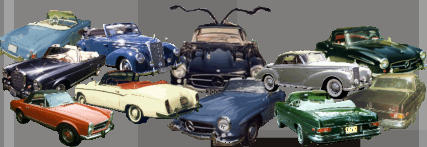
call Silver Star at 828-321-4268
220SEb / 250SE / 280SE Cabriolets and Coupes 1961 - 1971

INTRODUCTION and HISTORY
This luxurious model was the last of the hand-built Mercedes. Only
13 cars per week rolled off the production line. These cabriolets
and coupes are true classics. Unlike other automobiles, these cars
were classics the day they rolled off the production line, and have
remained so ever since.
The 220SEb was first introduced in 1961 and was considered to be
an immediate success. Road & Track magazine said "one of the
best-looking body designs to come from any German concern."
Exquisitely proportioned and beautifully designed. Luxurious may
very well be an understatement when describing this model. There
were no changes to the basic design until 1969. (Why mess with
perfection, huh?)
Because of the high demand for convertibles, many coupes have
been cut and converted into convertibles, especially the 280 SE 3.5
coupes (as they are the most sought-after of the cabriolets.) SO BE
CAREFUL! This has been done so by unscrupulous people in the
event of an unsuspecting customer that comes to purchase a
convertible. If you are looking at a convertible, make sure to check
the chassis number. If you are unsure of the car, call us with the
chassis number and we will be happy to help verify whether or not
it is a true cabriolet. If you purchase a false convertible, it can cost
you thousands of dollars. Click here for information on what to
avoid.
All of these coupes and convertibles are elegant, yet can still be
driven and maintained with no fuss. The later models with bigger
engines are preferred, such as the 300 SE, (see separate page)
which was rare when it was new, and is a definite keeper now. The
280 SE 3.5 convertible is a definite collectible because of it's power
and grace, and also because of the grille, which is lower and wider.
They are elegantly trimmed out with leather and hard-wood
veneer in the dash.
Production Numbers:
Production Numbers of the 220SEb from 1961 to 1965
Cabriolet chassis prefix is 111 023
engine prefix is 127 984
Coupe chassis prefix is 111 021
engine prefix is 127 984
Cabriolets
2729 units
Coupes
14173 units
Total:
16902 units
Production Numbers of the 250SE from 1965 to 1967
Cabriolet chassis prefix is 111 023
engine prefix is 129 980/981
Coupe chassis prefix is 111 021
engine prefix is 129 980/981
Cabriolets
954 units
Coupes
5259 units
Total:
6213 units
Production Numbers of the 280SE from 1968 to 1971
Cabriolet chassis prefix is 111 025
engine prefix is 130 980/984
Coupe chassis prefix is 111 024
engine prefix is 130 980/984
Cabriolets
1390 units
Coupes
3797 units
Total:
5187 units
Production Numbers of the 280SE 3.5 1969 to 1971
Cabriolet chassis prefix is 111 027
engine prefix is 116 980/990
Coupe chassis prefix is 111 026
engine prefix is 116 980/990
Cabriolets
1232 units
Coupes
3270 units
Total:
4502 units
A car's value is determined by condition. Standard condition
guidelines are as follows:
Excellent- As close to perfect original or a very well restored
vehicle. Generally a body-off restoration, but a well done body-on
restoration that has been fully detailed may qualify. The vehicle is
stunning to look at. Everything works as new, all equipment is
original, NOS or excellent quality reproductions. PLEASE KEEP IN
MIND THAT # 1 CARS ARE VERY RARE, AND ARE ORIGINAL RIGHT
DOWN TO THE HOSE CLAMPS. DO NOT ASSUME THAT JUST
BECAUSE A CAR HAS A #1 ASKING PRICE, THAT IT IS IN # 1
CONDITION. MOST CARS FOR SALE OUT THERE ARE LOW # 2 TO
HIGH # 3 CARS.
Very Good- An extremely presentable vehicle showing minimal
wear, or a well restored vehicle. Runs and drives smooth and tight.
Needs no mechanical or cosmetic work. All areas have been
detailed. Beautiful to look at but clearly not a # 1 vehicle.
Good- Presentable inside and out with some signs of wear. Not
detailed but clean. Body should be straight and solid with no rust-
through anywhere. Shiny, attractive paint but may have evidence
of minor fading or checking or other imperfections. Runs and
drives well but may need some minor mechanical or cosmetic
work. But it is useable and enjoyable as is.
Fair- Runs and drives ok but needs work throughout the vehicle.
Body shows signs of wear or previous restoration work. Any rust
should be minimal and not in any structural areas. Cosmetics,
body and mechanicals all need work to some degree.
Poor- In need of complete restoration, but is complete and not a
rust bucket beyond repair. May or may not run but is not
roadworthy.
Keep in mind that due to the high cost of restoration, mint
examples of these cars can and
have sold for more than the prices quoted here.
When looking for one of these cars, condition is everything. These
cars are large, and a complete restoration will become a costly
affair. Watch out for rust spots, (SEE PHOTOS BELOW) such as in
the headlight buckets, the edges of the wheelwells and in the
doors and rockerpanels. Trim condition is important because
replacement pieces are hard to find. Bumpers can be fixed and
replated if they are dented, but must be replaced if they are rusty.
Convertibles are usually in rougher shape than coupes because of
sun and water damage to the top and leather interior. The 220
through 280 coupes and cabriolets engines are based on the
sedans, therefore, mechanical parts for these cars are in no
shortage.
FRONT CROSS MEMBER
RUSTY FRONT ROCKER
PANEL ON DRIVERS SIDE
FLOOR BOARD
WHERE THE INNER
FENDER SUPPORT MEETS
THE FRAME RAIL. ALSO
CHECK THE FRONT CROSS
MEMBER WHERE THE
BUMPER MOUNTS
REAR LOWER TRUNK
SECTION RUST
REAR FENDER WHEELBASE
AREA. -THIS IS A COMMON
PLACE FOR RUST.
TYPICAL FRONT ROCKER
PANEL RUST. NOTE THE
PATCH SOMEONE MADE
OUT OF ROOFING
FLASHING MATERIAL AND
POP RIVETED IN PLACE!
LEFT INNER FRONT
FENDER- BATTERY AREA.
RUST PRONE DUE TO
BATTERY ACID. (NOTE ON
3.5 CARS: BATTERY IS ON
THE RIGHT INNER FENDER)
These cars can be found as excellent originals, and they are worth
looking for. You can save money on your restoration if you
purchase an automobile that is in fair to good condition. Condition
of a car CANNOT be determined by its location. Don't be fooled by
a car's current geographical location. Just because a car is in
California today, does not mean that is where it started life.
Look at the car in general. Walk around the car several times
looking at the gaps for the doors, trunk and hood. Look at the
general overall condition of the car.
Where to find the engine number and chassis number: You will
find the body plate on the radiator core support. This plate will
give useful information if you know how to "decode" it. This was
the factory's "build plate" it gives the color code, and option codes
to which the car was built. DO NOT confuse the numbers on this
plate with the VIN number (or chassis number)of the car. VIN
number is stamped on the right front frame rail. Also stamped on
the radiator core support. Later models (after 1968) have a plate
pop riveted to the windhield pillar post and a data plate on the
inside door. But because these plates can be removed, and/or
replaced, always check the one stamped into the right front frame
rail. Use the illustration for location of plates
1.
Type plate
2.
Chassis number
stamped on right
front side member
3.
Body and number
plate
4.
Engine plate
VIN #'s are as follows:
Cabriolet
Coupe
Model
chassis prefix
chassis prefix
Engine prefix
220SEb
111 023
111 021
127 984
250SE
111 023
111 021
129 980/981
280SE
111 025
111 024
130 980/984
280SE 3.5
111 027
111 026
116 980/990
ALWAYS put your intended purchase on a lift, up in the air to fully
inspect (and poke if necessary) the bottom undercarriage of the
car. Any owner who won't allow this may have something to hide.
The best tool to use for checking the condition of body panels are
your hands. The following illustration will show the most common
rust areas.
Oil leakages: all older Mercedes have some small oil leakages.
Valve guides, valve stem seals, play in piston ring. An exhaust oil
cloud after strong acceleration points to defective valve stem seals
or valve guides – play in or worn large piston ring are frequently
also a cause.
Fuel pipes may be porous.
Transmission weaknesses – pay attention to wear
Additionally the chassis may have the following weaknesses:
Rubber seals : Aged by drying-out or dissolved by engine oil, which
is distributed by the wind over the chassis bottom.
Tie rods: may be worn
Steering damper: may be worn, and not work correctly
Brake hoses: Ageing - the brake hoses fill-up from the inside,
reducing the passage, life span is 15 years (manufacturing date is
imprinted)
Water hoses
Front king pins





# 5
# 4
# 3
# 2
# 1
220SEb Cabriolet
$14,850.00
$30,900.00
$55,400.00
$78,000.00
$120,700.00
220SEb Coupe
$4,150.00
$8,600.00
$14,900.00
$28,350.00
$44,800.00
250SE Cabriolet
$16,050.00
$40,175.00
$64,825.00
$91,250.00
$136,400.00
250SE Coupe
$4,475.00
$9,300.00
$16,975.00
$32,325.00
$51,075.00
280SE Cabriolet
$27,150.00
$49,900.00
$76,100.00
$110,000.00
$144,400.00
280SE Coupe
$5,100.00
$10,600.00
$19,400.00
$36,900.00
$57,700.00
280SE 3.5 Cabriolet
$65,750.00
$109,575.00
$168,975.00
$224,000.00
$296,075.00
280SE 3.5 Coupe
$8,925.00
$21,725.00
$43,975.00
$74,000.00
$112,600.00






















































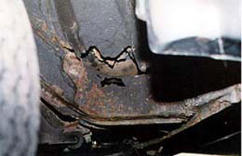

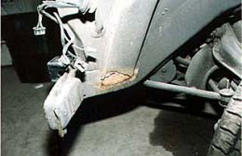

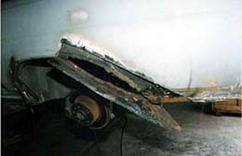
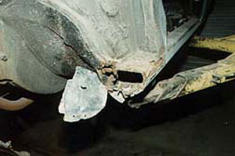
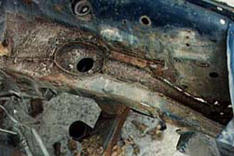
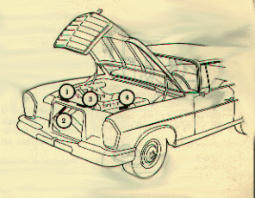

Technical Specifications 220 SEb
Engine Type:
6 cyl ovrhd camshaft (M 127)
Bore and stroke:
80 x 72.8mm (3.41 x 3.1 in)
Displacement:
2195 cc (133.9 cu in)
Power output:
115 hp (DIN) @ 4800 rpm (134 hp SAE @ 5000 rpm)
Compression ratio:
8.7:1
Torque:
19 mkg @ 3800 rpm
Fuel Injection:
Bosch 2 plunger pump
Engine speed at 100km/hr:
3470 rpm
Gear ratios:
I. 3.64:1
Automatic
I.3.98:1
II.2.36:1
II. 2.52:1
III.1.53:1
III. 1.58:1
IV 1.00:1
Rear axle ratio:
4.10
Chassis:
unit frame and body
Suspension:
independent front, single joint swing axle rear, with coil
springs
Brakes and area:
disc front -- drum rear
Wheelbase:
2750 mm(108.3 inches)
Track front/rear:
1482/1485 mm
Length:
4880 mm (192.1 inches)
Width:
1845 mm (72.7 inches)
Height:
1440 mm(57 inches)
Ground clearance:
185 mm (7.3 inches)
Tires:
coupe: 7.25 x 13 --- cabriolet 750 x 13
Turning circle:
12.1-11.9 meters (39 feet)
Steering type and ratio:
22.7:1 (4.1 turns)
Weight:
coupe: 3102 lbs. --- cabriolet: 3322 lbs
Maximum speed:
172 km/hr (107mph)
Acceleration:
14 sec 0-100 km
Fuel consumption
14 L super/100 km16.75 mpg
Fuel tank capacity
75 L (17.2 gal)




























































Technical Specifications 250 SE
Engine Type:
6 cylinder overhead camshaft (M129)
Bore and stroke:
82 x 78.8 mm
Displacement:
2496 cc
Power output:
150 hp
Compression ratio:
9.3:1
Torque:
22 mkg @ 4200 rpm
Carburetion:
Bosch two plunger pump
Engine speed at 100km/hr:
3245 rpm
Gear ratios:
I. 4.05:1
Automatic
I. 398:1
II. 2.23:1
II. 2.52:1
III. 1.42:1
III. 1.58:1
IV. 1.00:1
IV. 1.00:1
Rear axle ratio:
3.92
Chassis:
unit frame and body
Suspension:
independent front and rear, with coil springs, single joint
swing axle
Brakes and area:
disk, servo assist, two circuit hydraulic, 273/279 mm
Wheelbase:
2750 mm (108.3 inches)
Track front/rear:
1482/1485 mm
Length:
4880 mm (192.1 inches)
Width:
1845 mm (72.6 inches)
Height:
coupe: 1420 mm (55.9 inches)
cabriolet 1435 mm (56.5 inches)
Ground clearance:
152 mm (5.9 inches)
Tires:
7.35 H 14 or 185 H 14
Turning circle:
12.1 - 11.9 meters
Steering type and ratio:
recirculating ball, 22.7:1
Weight:
coupe: 3378 lbs. -- cabriolet: 3465 lbs.
Maximum speed:
120 mph
Acceleration:
12 sec 0-100km/hr
automatic: 13 sec. 0-100 km/hr
Fuel consumption:
16 L, super/100 km (14.7mpg); automatic:17 L,super
(13.7 mpg)
Fuel tank capacity:
82 L (21.7 gal)




























































Technical Specifications 280 SE
Engine Type:
6 cylinder overhead camshaft (M 130)
Bore and stroke:
86.5 x 78.8 mm
Displacement:
2778 cc
Power output:
160 hp (DIN) @5500 rpm
Compression ratio:
9.5:1
Torque:
24.5 mkg @ 4250 rpm
Carburetion:
Bosch 6 plunger pump
Engine speed at 100km/hr:
3140 rpm
Gear ratios:
I. 3.98:1
II. 2.39:1
III. 1.46:1
IV. 1.00:1
Rear axle ratio:
3.92 (4.08 for U.S.)
Chassis:
unit frame and body
Suspension:
independent front and rear, with coil springs, single joint
swing axle, anti-sway bars
Brakes and area:
disk, power assisted, standard, 273/279mm
Wheelbase:
2750 mm (108.3 inches)
Track front/rear:
1482/1490 mm
Length:
4900 mm (192.9 inches)
Width:
1810 mm (71.3 inches)
Height:
1440 mm (56.7 inches)
Ground clearance:
175mm (6.9 inches)
Tires:
7.35 H 14 or 185 H 14
Turning circle:
12.5 meters (41 feet)
Steering type and ratio:
recirculating ball, 4 turns, servo assisted, 3.0 turns
Weight:
coupe: 3330 lbs --- cabriolet: 3495 lbs.
Maximum speed:
118 mph
Acceleration:
10.5 sec 0-100km/hr
Fuel consumption:
12.5 L, super/100 km (14.7mpg);
Fuel tank capacity:
82 L (21.7 gal)




























































Technical Specifications 280 SE 3.5
Engine Type:
V-8 cyl overhead camshaft, one for each bank (M 116)
Bore and stroke:
92 x 65.8 mm
Displacement:
3499 cc
Power output:
200 hp (DIN) @ 5800 rpm
Compression ratio:
9.5:1
Torque:
29.2 mkg @ 4000 rpm
Fuel Injection:
Bosch electronic
Engine speed at 100km/hr:
2945 rpm
Gear ratios:
I. 3.98:1
II. 2.39:1
III. 1.46:1
IV. 1.00:1
Rear axle ratio:
3.69
Chassis:
unit frame and body
Suspension:
independent front and rear, with coil springs, single joint
swing axle
Brakes and area:
disk, servo assist, two circuit hydraulic, 273/279 mm
Wheelbase:
2750 mm (108.3 inches)
Track front/rear:
1482/1485 mm (58.4-58.6 inches)
Length:
4880 mm (192 inches)
Width:
1845mm (72.6 inches)
Height:
1395 mm (54.9 inches)
Ground clearance:
152 mm (6 inches)
Tires:
7.35 H 14 or 185 H 14
Turning circle:
12 meters (39.4 feet)
Steering type and ratio:
recirculating ball, 3.2 turns, servo assisted
Weight:
convertible, 3463 lbs. --- coupe: 3641 lbs.
Maximum speed:
127 mph
Acceleration:
9.5 sec 0-100km/hr
Fuel consumption:
13 L, super/100 km (18mpg);
Fuel tank capacity:
82 L (21.7 gal)





























































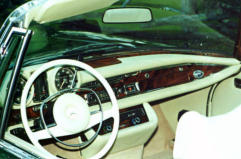


- 220 Cabriolet A and 220 Cabriolet B 1951-1955
- 300 -300b -300c - 300d Convertible Sedan 1951-1962
- 300S - 300Sc Cabriolet / Coupe / Roadster 1951-1958
- 300SL Gullwing and Roadster 1954-1962
- 190SL Roadsters 1955-1963
- 220S / 220SE Cabriolets & Coupes 1956-1960
- 300SE Cabriolets & Coupes 1962-1967
- 220SEb/250SE/280SE/280SE 3.5 Cabriolets & Coupes 1961-1971
- 230SL/250SL/280SL Roadsters 1963-1971













